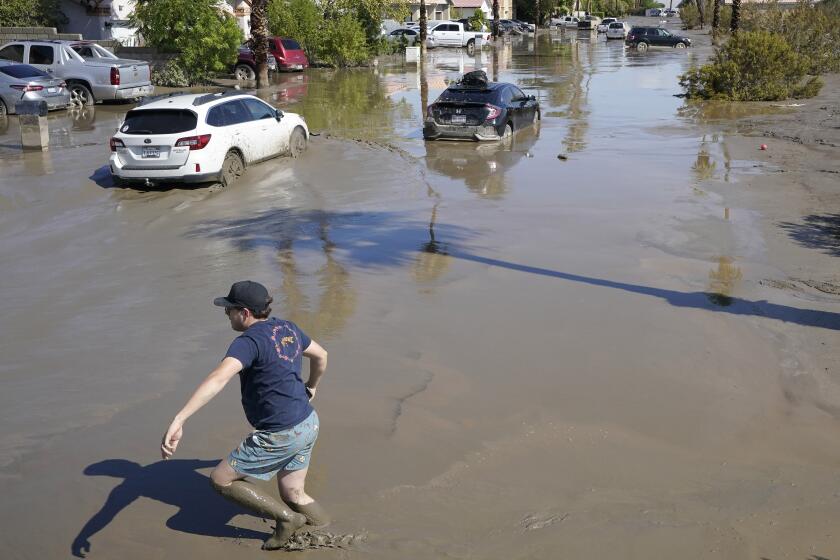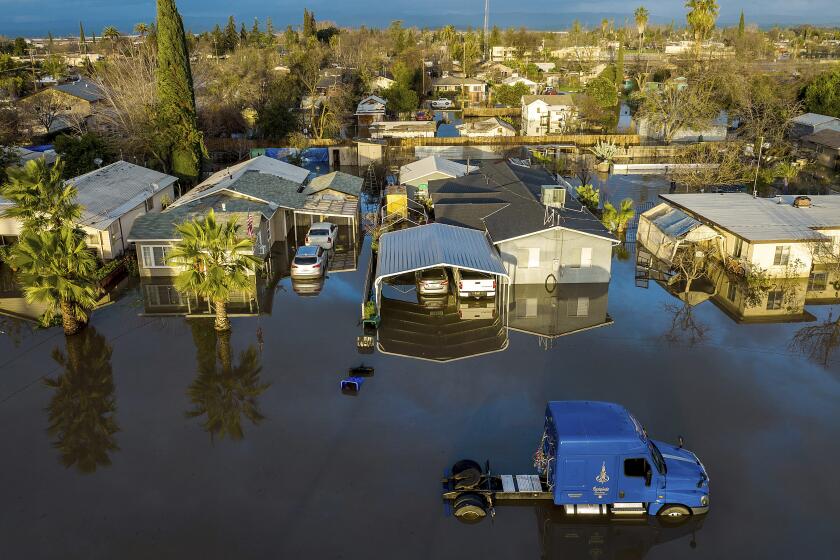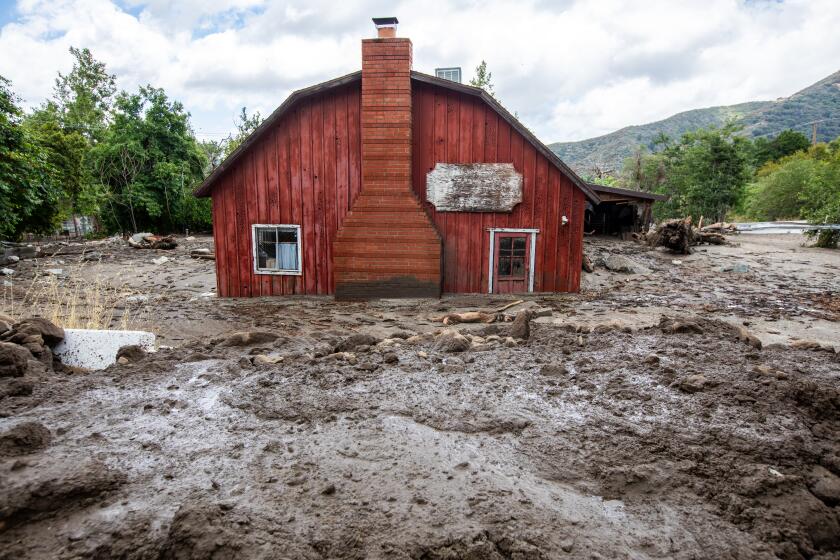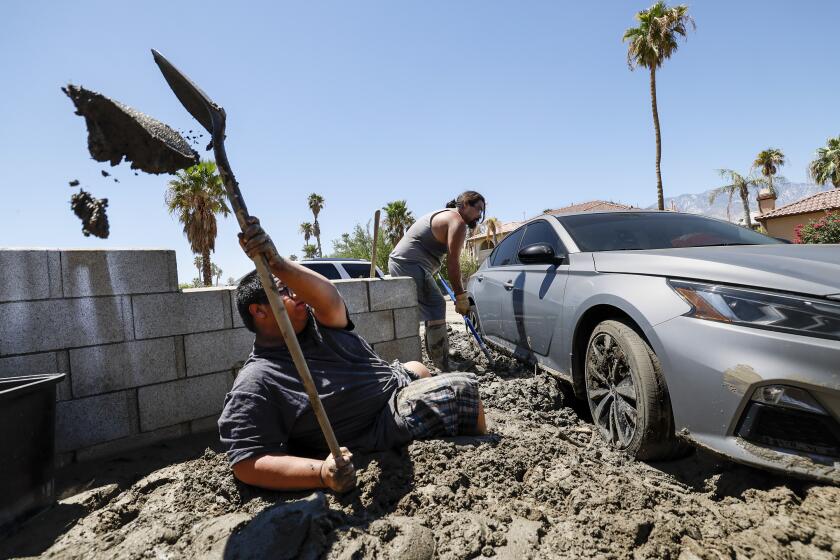Hilary flooded your home. Will insurance cover the damage?

- Share via
Whether you hunkered down or evacuated during the first tropical storm in Southern California in 84 years, you’re probably starting now to assess the damage Hilary left behind over the weekend.
Some areas of the region experienced little to no harm, but communities within San Bernardino County, Riverside County, Antelope Valley and Coachella Valley are looking at wreckage caused by debris flow and flooding.
If your home was in the path battered by Hilary, you may be able to get help from your homeowners insurance. But much depends on the type of damage you incurred, because some of what Hilary threw Southern California’s way is not covered by the standard policy.
The first tropical storm to hit Los Angeles in 84 years dumped record rainfall and turned streets into muddy, debris-swollen rivers.
When can I check my property?
If an evacuation order by the local sheriff’s or fire department is in place for your neighborhood, do not return to your home until the order has been lifted.
Once it is lifted, it still might not be safe for you to go if the roads leading to your home are flooded, said Omar Ochoa, Texas-based attorney and storm insurance expert.
So before you head home, check for road closures. Here are some resources:
- The Los Angeles County Public Works Department has an online map that displays closures and offers brief explanations (ex: “Closed due to flooding”).
- San Bernardino County Public Works has an online road closure map.
- Riverside County’s Transportation Department has an online road closure map.
What does insurance cover?
The typical homeowners policy covers damage caused by wind and the rain falling onto your house — for example, if your roof is blown off or the rain coming through a leak ruins your bedroom carpet. It also covers the damage from falling trees under certain circumstances — for example, if it was a sickly tree on your property, the insurer could argue that the storm wasn’t the main reason it fell down.
On the other hand, most homeowners insurance policies do not cover damage caused by floods, mudslides, debris flows or similar disasters, according to the California Department of Insurance. Flood insurance, which is sold by the National Flood Insurance Program mainly to people who live in flood zones, covers damage from floods and mudflows, but not gravity-induced mudslides, the Insurance Information Institute says on its website.
There is an exception, the state agency says, if the flood, mudslide or debris flow was caused directly or indirectly by a recent wildfire or another hazard covered by your policy. To be sure, check with your insurance provider.
The same limitations apply to renters insurance policies. If your laptop is ruined by rain pouring in from a hole in the roof, you can get reimbursed. But if it’s ruined by floodwaters, your renters policy won’t cover it.
Renters across Southern California are facing flood damage caused by the recent series of storms. Here’s how they can protect themselves and their personal property.
If you don’t have separate flood insurance, you can apply for help from the U.S. Small Business Administration through its Disaster Loan Assistance program — even if you don’t have a business. It’s a long-term, low-interest loan to assist with the rebuilding and repair of damaged property.
Homeowners in a declared disaster area may borrow up to $100,000 to repair or replace clothing, furniture, cars or appliances damaged or destroyed in a disaster.
If you submitted a claim and your insurer denies it, you can dispute the decision, Ochoa said. He recommended that you get legal assistance, however, given how complicated the language is in the typical insurance policy.
If you don’t get reimbursed for your lost items, you can deduct the amount you lost on your state and federal tax returns.
Taxpayers in a federally declared disaster area who suffer uninsured or unreimbursed disaster-related losses can claim them on their returns for the year of the loss or the previous year.
When filing your taxes, write the disaster number assigned by the Federal Emergency Management Agency on any return claiming a loss.
Online scammers are eager to tap into people’s need for aid as well as their desire to help. Be careful before you reveal sensitive personal information or open your wallet.
Protecting yourself against flood losses
You should consider buying flood insurance if your house could be flooded by melting snow, an overflow creek or pond, or water running down a steep hill, the Insurance Information Institute advises.
A flood insurance policy is only for a home that you live in, Ochoa said. Rental properties that you don’t live in aren’t eligible for the program.
Such a policy covers up to $250,000 worth of damage to the structure and $100,000 for damage to your personal possessions (based on their current value).
After days of urgent warnings, Tropical Storm Hilary made landfall in Baja California on Sunday, turning roads into rivers and imperiling homes before barreling north toward Southern California.
The amount for personal possessions may be considerably less than what it’ll cost to replace them, especially if they’re older and have depreciated in value. In any case, make a list of valuable items in case of an emergency.
Flood coverage is available to anyone living in one of the 24,000 participating communities or in a flood-prone area. You can check whether your community is part of the National Flood Insurance Program by checking the “community status report” on its website.
If your community is listed, you can obtain a flood policy from a participating insurer. The program offers a list on its website.
The policy won’t go into effect until 30 days after its purchased.
Another flood insurance option is private insurance providers. There are two types: primary flood insurance and excess flood insurance.
Primary flood insurance is similar to the FEMA program but generally offers higher levels of coverage, according to the Insurance Information Institute.
Excess flooding insurance is available for homeowners who need more protection than what the federal program can offer or who live in an area that doesn’t participate in it. This type of insurance can be purchased from specialized companies through independent insurance agents or some regular homeowners insurance companies.
What if my car has been damaged?
Flood damage to cars, including flooding from a storm surge, is covered if you have “comprehensive coverage,” also known as “other than collision” coverage, as part of your auto insurance.
Comprehensive coverage is optional with a standard auto policy.
About The Times Utility Journalism Team
This article is from The Times’ Utility Journalism Team. Our mission is to be essential to the lives of Southern Californians by publishing information that solves problems, answers questions and helps with decision making. We serve audiences in and around Los Angeles — including current Times subscribers and diverse communities that haven’t historically had their needs met by our coverage.
How can we be useful to you and your community? Email utility (at) latimes.com or one of our journalists: Jon Healey, Ada Tseng, Jessica Roy and Karen Garcia.
More to Read
Sign up for Essential California
The most important California stories and recommendations in your inbox every morning.
You may occasionally receive promotional content from the Los Angeles Times.















